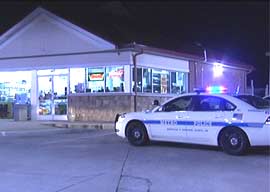
June 17, 2013

I didn”t expect to see so many derelicts in Music City USA. I thought the home of country music would be a little more…country?
Last week I fled the Atlanta metro area to spend three days in Nashville for my birthday. As a Philly-born expat who’s lived in all four corners of the USA, I”ve lived south of the Mason-Dixon Line and east of the Mississippi River for nearly seven years. I”m especially fond of the Upland South, which includes nearly all of Tennessee except its western lowland fringes that are capped off by that ugly and battered fake gold tooth called Memphis.
Since Nashville is a country-music mecca surrounded by rolling mountain greenery, I anticipated something far more wholesome and unspoiled, something more befitting the Upland South than the South Bronx. I thought I”d see red-and-white checkered shirts, cowboy hats, and hoop skirts. What I saw were dreadlocks, sideways baseball caps, and stained sweatpants.
Much of this was due to my motel’s location, perched right off Interstate 65 on the city’s east side, across the Cumberland River from downtown and Music Row. The latter areas were clean and unexceptional. But except for the shimmering glass-and-steel C&W museums where I presume you”re able to view an array of Porter Wagoner’s nudie suits for $20, it could have been any relatively unthreatening downtown area in America. Except for the tourist traps, downtown Nashville could have easily been downtown Spokane or downtown Indianapolis. But the east side was more like Detroit.
Whereas the downtown area featured new neon and glittering hotels, the east side had old neon and lodging of a decidedly more downscale nature. East Nashville remains somewhat visually interesting because it has escaped the brute beige force of gentrification and urban renewal. Here on the mangy, flea-ridden side of town, it’s all cracked cement, overgrown weeds, barbecued-rib shops, and used-tire stores.
I knew there would be poverty in Nashville”this is Tennessee, after all”but what astonished me was the utter lack of country rusticity. I wasn”t expecting Beverly Hills, but for some reason I thought the poor people would look more like Li”l Abner than Lil Jon. In short, I expected to see more hillbillies and fewer gangbangers and wiggers. But east Nashville is a place where “Music City“ has a distinctly different meaning.
Sure, there were scraggly shirtless cigarette-smoking white homeless men clustered in packs under tree shade. There were sunburned bikers wearing German helmets. There were 400-pound grit-gobbling pasty women waddling out of diners with their 300-pound sausage-gnawing ofay mates. But after a while it became evident that anyone who might fit the cultural stereotype of a “redneck” skewed older than average.
Most of the younger proles on Nashville’s east side”and numerically they seemed about evenly split between blacks and whites”fit more of an “inner-city” stereotype. America’s underclass has by definition always been poor, but they used to be somewhat culturally different from one another. But now the hillbillies are dying out, and in the proletarian interracial culture wars, black urban culture has won. All the poor whites”or at least the “youths” and a surfeit of middle-aged (or perhaps prematurely aged) white welfare mothers”now seem to act black. And dress black. And talk black.
At least that’s the impression I got during a ten-minute visit to an east Nashville gas-station convenience store to buy a frosty beverage on a hot and humid June afternoon.
Upon entering, I was met by a glowering pair of gangsta types with corn rows, oversized shirts, and teardrop tattoos under their eyes.
The place was what one might expect from any inner-city convenience store: rolling papers, flavored cigarillos, lottery tickets, herbal stimulants, condoms, and reputed libido-enhancing supplements encased behind a wall of Plexiglas. At the cash register stood a sweaty and swarthy clerk of apparent Hindu derivation. Cramped food aisles featured snacks and treats crammed to the gills with sodium and sugar. Beef jerky was abundant, and I doubt there was a gram of dietary fiber in the entire establishment.
As I surveyed the refrigerated soft-drink section, a very short and stocky white male who resembled a semi-retarded junior-league rugby player grabbed a beer from behind an adjacent glass door. A pale, pear-shaped, and bedraggled white woman kept telling her three mulatto children that they”d had enough candy while they kept pestering her for more.